NEC EA294WMi 29" Monitor Review: 21:9 At Twice The Price
Last month, we reviewed AOC’s Q2963PM ultra-wide monitor at 2560x1080. Based on the same LG panel, NEC brings us its EA294WMi. Selling for almost twice as much, does this screen offer two times the performance and features? Our tests give you the answer.
Results: Grayscale Tracking And Gamma Response
The majority of monitors, especially newer models, display excellent grayscale tracking (even at stock settings). It’s important that the color of white be consistently neutral at all light levels from darkest to brightest. Grayscale performance impacts color accuracy with regard to the secondary colors: cyan, magenta, and yellow. Since computer monitors typically have no color or tint adjustment, accurate grayscale is key.
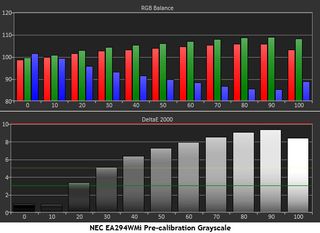
We measured every color temp mode to find the best out-of-box result. While the sRGB option claims to be 6500 K, our results showed a Delta E error of 6.49, which is quite high. The best preset to use is number two, which measures an average of 4.46 Delta E. The chart above shows the Native preset, which is the default setting. With a steep decline in blue as you get brighter, whites look quite warm in this mode.
Here’s the chart after calibrating the number two preset.
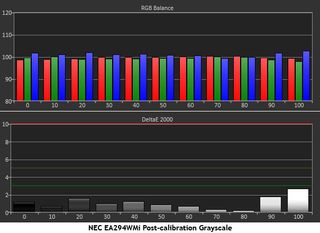
This is an excellent result, especially in the 50- to 80-percent brightness range. The rise in blue at 90 and 100 percent isn’t too bad; in fact, it shouldn't be visible. You’ll need to back off the Contrast control to tame the brightest whites.
Let’s bring our comparison group back into the mix.

We used the result from color temp mode two in the final comparison. It’s still visibly warm, but better than NEC's Native preset. A 4.46 Delta E is the best we could do. It’s disappointing that the sRGB preset doesn’t measure below a Delta E value of 3, especially for a monitor this expensive. Remember that you can’t adjust the sRGB preset. Memories 1, 2, 3, and 5 are fully adjustable.
Fortunately, after calibration, the results are much better.
Stay on the Cutting Edge
Join the experts who read Tom's Hardware for the inside track on enthusiast PC tech news — and have for over 25 years. We'll send breaking news and in-depth reviews of CPUs, GPUs, AI, maker hardware and more straight to your inbox.
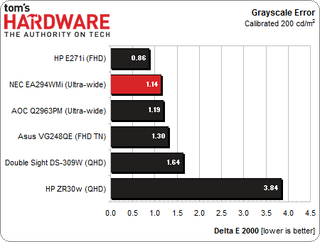
A 1.14 Delta E measurement puts the EA294WMi in second place here, and sixth overall for 2013. We would like to see better stock numbers at NEC's $750 price point, but those who choose to calibrate will be rewarded for their efforts.
Gamma Response
Gamma is the measurement of luminance levels at every step in the brightness range from 0 to 100 percent. This is important because poor gamma can either crush detail at various points or wash it out, making the entire picture appear flat and dull. Correct gamma produces a more three-dimensional image, with a greater sense of depth and realism. Meanwhile, incorrect gamma can negatively affect image quality, even in monitors with high contrast ratios.
In the gamma charts below, the yellow line represents 2.2, which is the most widely accepted standard for television, film, and computer graphics production. The closer the white measurement trace comes to 2.2, the better.
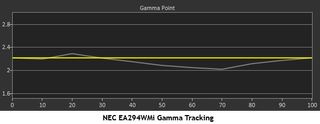
We're quite pleased with the EA294WMi's result. We’ve seen gamma results that range from fair to poor in many monitors, but NEC does well in this metric. Flat gamma tracking at 2.2 means that image depth and dimensionality will be consistent, no matter what content you're looking at. Obviously, NEC’s choice to omit gamma control is not a problem.
Here’s our test group again for the gamma comparisons.
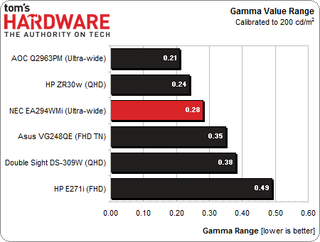
Just like the trace in the picture above, you can see that the EA294WMi exhibits very flat gamma tracking performance. Though we’d love to see multi-point gamma controls on every monitor, it wouldn’t make much difference here.
We calculate gamma deviation by simply expressing the difference from 2.2 as a percentage.

Our best screens deviate from the correct gamma by only a few percent at most. NEC's EA294WMi is comfortably in that group. The 3.18-percent deviation we measured represents a maximum error of less than 7 cd/m2.
Current page: Results: Grayscale Tracking And Gamma Response
Prev Page Results: Brightness And Contrast Next Page Results: Color Gamut And Performance
Christian Eberle is a Contributing Editor for Tom's Hardware US. He's a veteran reviewer of A/V equipment, specializing in monitors. Christian began his obsession with tech when he built his first PC in 1991, a 286 running DOS 3.0 at a blazing 12MHz. In 2006, he undertook training from the Imaging Science Foundation in video calibration and testing and thus started a passion for precise imaging that persists to this day. He is also a professional musician with a degree from the New England Conservatory as a classical bassoonist which he used to good effect as a performer with the West Point Army Band from 1987 to 2013. He enjoys watching movies and listening to high-end audio in his custom-built home theater and can be seen riding trails near his home on a race-ready ICE VTX recumbent trike. Christian enjoys the endless summer in Florida where he lives with his wife and Chihuahua and plays with orchestras around the state.
-
runswindows95 Considering this screen is $805 for this monitor on Newegg, I rather get a nice 2560X1440, like the Dell U2713, for the money, or dual 1920X1200 screens. 2560X1080 really isn't an ideal resolution for any practical application.Reply -
TBC1 Reply11821147 said:Triple Post! Triple Post! Triple Post! But yeah too much money
Darn thing lagged on me!
-
Vorador2 Well this is a professional monitor so the high price is not that surprising. Still if i were on the hunt for a monitor this wouldn't be my choice.Reply -
burkhartmj You could get 2 Dell Ultrasharp U2412M's plus a dual monitor mount for the price of this, it just doesn't make sense at this price point.Reply
There's also the issue of ultra wide screen. This seems to have a niche market that doesn't exist, a professional grade monitor that's only particularly good at watching movies. People who just watch TV and movies all day aren't going to be willing to spend more than 250 on a monitor , and those who want/need professional features will want as much screen real estate as possible, opting for large 16:9 or 16:10 monitors.
This is exacerbated by the fact that this aspect ratio is literally ONLY helpful for movies, not even TV. having big black bars on each side during a TV show or older movie that doesn't have the cinematic aspect ratio is way more distracting than the thin bars at the top and bottom created by cinematic movies on normal 16:9/10 monitors. -
jasonpwns I dislike this new trend. I'd rather have a 27 inch with 2560x1440. Why are we constantly trying to lower our screen resolutions. This 1080p trend needs to stop.Reply -
InvalidError Reply
I would prefer 2560x1600 on a 24" screen myself.11822582 said:This 1080p trend needs to stop.
The problem is the bulk of offer and demand gravitates around 1920x1080 since that is what most common forms of entertainment are optimized for. With 1080p screens starting as low as $90, anything higher than that for 3-5X the price becomes a tough sale so these higher-resolution monitors get pitched and priced as "professional" displays instead of trying to compete for people's desktops.
I paid $270 for my 24" 1200p display four years ago. Equivalent models today are usually listed around $400. To me, this seems to indicate that mainstream interest in higher resolution desktop displays has regressed, hence the switch to pitching those nearly exclusively at professionals and enthusiasts. -
mortsmi7 Seems to me that if your a fan of the 4:3 ratio, and want a seamless dual monitor experience, this might be the way to go. For once, a person might have reasonable room to put two windows side by side. And it sure as hell takes up less desk space than two separate monitors.Reply
Most Popular

